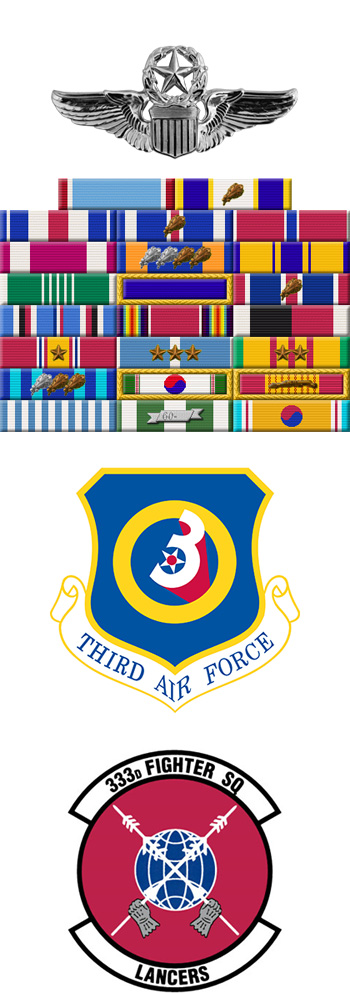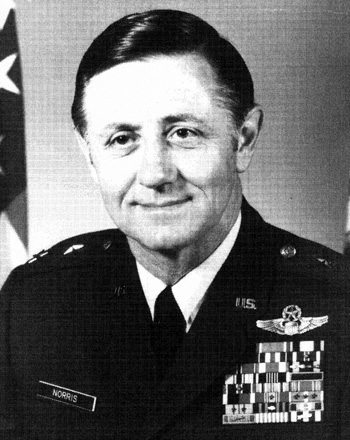
|
William C. Norris |
 |
|||
| Rank, Service | ||||
Major General O-8, U.S. Air Force |
||||
| Veteran of: | ||||
|
||||
| Tribute: | ||||
Bill Norris was born on September 20, 1926, in Port Jervis, New York. He enlisted in the U.S. Army Reserve on January 11, 1944, and went on active duty in the U.S. Army Air Forces on February 23, 1945, serving as a flight engineer until going into the Air Force Reserve on December 3, 1946. Cpl Norris remained in the reserves until going back on active duty in the Aviation Cadet Program of the U.S. Air Force on February 20, 1948, earning his commission as a 2d Lt and his pilot wings at Williams AFB, Arizona, on February 25, 1949. Lt Norris next flew F-84 Thunderjets with the 20th Fighter Group at Shaw AFB, South Carolina, from 1949 to March 1951, when he deployed to Japan flying F-80 Shooting Stars from March to April 1951. He then flew F-51 Mustangs in combat in Korea from April to October 1951 with the 39th Fighter-Interceptor Squadron of the 18th Fighter-Bomber Wing. Capt Norris then completed All-Weather Interceptor School and served with the 54th Fighter-Interceptor Squadron at Ellsworth AFB, South Dakota, from March 1952 to January 1959, followed by service with the 449th Fighter-Interceptor Squadron and the 11th Air Division at Ladd AFB, Alaska, from January 1959 to September 1960. His next assignment was on the staff of the 3750th Air Base Group at Sheppard AFB, Texas, from September 1960 to September 1960. Maj Norris attended Air Command and Staff College at Maxwell AFB, Alabama, from September 1961 to June 1962, and then served on the staff of Headquarters Air Defense Command at Ent AFB, Colorado, from July 1962 to June 1965. He next served on the staff of the 4756th Air Defense Wing and then as Commander of the 4757th Air Defense Squadron at Tyndall AFB, Florida, from June 1965 to November 1966, followed by service as Chief of the Operations Branch for the 355th Tactical Fighter Wing at Takhli Royal Thai AFB, Thailand, from November 1966 to January 1967. Col Norris served as Operations Officer and then Commander of the 333rd Tactical Fighter Squadron at Takhli from January to August 1967, and then served as Assistant Executive Officer to the Chief of the National Guard Bureau at the Pentagon from October 1967 to August 1968. His next assignment was as Deputy Director and then Director of Operational Inspection with Headquarters Aerospace Defense Command at Ent AFB from August 1968 to August 1970, followed by Air War College at Maxwell AFB from August 1970 to May 1971. Col Norris served as Vice Commander and then Commander of the 50th Tactical Fighter Wing at Hahn AB, West Germany, from July 1971 to February 1973, and then served as Commander of the 20th Tactical Fighter Wing at RAF Upper Heyford, England, from February to November 1973. Gen Norris next served as Deputy Chief of Staff for Plans with Headquarters U.S. Air Forces in Europe (USAFE) at Ramstein AB, West Germany, from November 1973 to July 1974, followed by service as Inspector General of USAFE from July 1974 to August 1975. His next assignment was as Commander of Headquarters Command at Bolling AFB, Washington, D.C., from August 1975 to June 1976, and then as Commander of the 76th Airlift Division at Andrews AFB, Maryland, from June 1976 to July 1977. His final assignment was as Commander of 3rd Air Force at RAF Mildenhall, England, from August 1977 until his retirement from the Air Force on July 1, 1980. |
||||
|
||||

